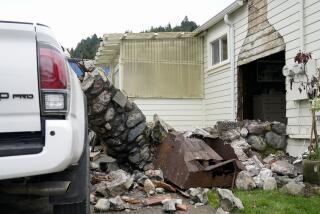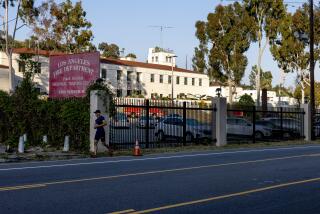Weather Service to Receive State-of-Art Radar System
- Share via
The federal government plans to build two weather facilities in Southern California and another in Arizona to house a sophisticated new radar system that will enable forecasters to predict the weather with greater precision, officials told The Times.
The National Weather Service, in a joint program with the Federal Aviation Administration and the military, plans new $1-million facilities atop Sulphur Mountain south of Ojai in Ventura County, at the Miramar Naval Air Station in San Diego and at the Yuma Airport.
The facilities will be built over the next seven years as the part of a nationwide NEXRAD (for next generation radar) system using Doppler radar, which officials say must be located away from the electronic pollution found in metropolitan areas.
As part of the NEXRAD project, the Weather Service will decentralize its forecasting functions, according to Thomas H. Grayson, the service’s Western regional director.
Weather Service forecasting for Southern California is centered in Los Angeles, with a smaller service office in San Diego.
Under NEXRAD plans, the Los Angeles staff of 30 will be cut by 10 and its forecasting functions will be narrowed, said Arthur Lessard, Los Angeles director.
The San Diego office is to be expanded into a full forecasting center, with about twice its present staff of 10, and the office, currently based at Lindbergh Field, is slated to be moved to Miramar.
Also likely to be part of the NEXRAD plan is the relocation of the Los Angeles office from the federal building in Westwood, most likely to a site in Ventura County, but possibly the Sepulveda Basin in the San Fernando Valley.
The changes are part of numerous such moves nationwide by the Weather Service caused by placement of the new radar. The New York City office, for instance, is slated to move out of Rockefeller Center to Long Island and the Atlanta office is moving 30 miles outside the city.
Grayson said 114 Doppler radar systems will be installed throughout the United States for use by the Weather Service. The radar is named after 19th-Century Austrian physicist Christian Johann Doppler who first described how moving objects shift the frequency of sound and light waves that they emit or reflect.
Just coming into use for weather forecasting, Doppler so far has been used only by a few private forecasters in the Midwest, where it is touted as a tremendous aid to forecasters charged with providing tornado warnings.
While Southern California does not have a significant tornado problem, Grayson said Doppler radar “will put us light-years ahead of where we are now in weather forecasting.”
Not only can Doppler detect the relative motion of air masses and water droplets within storms, but it can estimate much more closely than before probable wind shears and the quantities of rain to be expected in a given area.
The aging radar now used in weather forecasting shows the areas within storms where rain is falling. Doppler radar can show the motion of rain toward or away from the radar site, thus giving forecasters a much better view of the winds.
According to the Doppler effect, as a storm moves toward or away from a given point, the wavelength of the signal reflected to the radar is lengthened or shortened. The signal changes much like the pitch of a train whistle as the train approaches and recedes from a listener at a fixed point.
Analyzing wavelength changes, Doppler can show not only which way the storms are moving, but even the direction that the raindrops are falling.
Grayson said NEXRAD’s Doppler installations will create “optimum coverage, an umbrella for all of Southern California,” designed to tell forecasters the direction and strength of weather disturbances along both winter and summer storm tracks.
The head of NEXRAD’s joint project office in Silver Spring, Md., Tony Durham, said last week that the system, when fully operational, will bring about what he termed “a revolutionary change in the nature of weather forecasting” even in areas of generally mild weather such as the Southland.
For instance, with its 150-mile effective range, Durham said, the radar placed atop Sulphur Mountain will allow much more precise estimates of flash flood probabilities in the foothills of the San Gabriel Mountains.
He added that forecasters also will be able to make much more accurate estimates of rainfall quantities throughout the Los Angeles area.
But some of the changes have raised controversy.
Some employees in the Los Angeles office do not want the office moved. Joined by a UCLA meteorologist, they are also challenging the choice of Sulphur Mountain as the radar site closest to Los Angeles, claiming it is not the best location.
A Feb. 2 letter to Grayson from a group of employees who did not sign their names declared:
“Doppler radar will significantly improve our storm detection and public warning capability. However, the Sulphur Mountain site is not the best for ‘protecting’ the Los Angeles area. Selection of a radar site closer to Los Angeles will allow maximum use of Doppler’s improved warning capability.”
Meanwhile, Roger Wakimoto, an assistant UCLA meteorology professor, wrote Grayson in December arguing that the Sulphur Mountain site is too far from Los Angeles and is blocked by too many mountains to afford optimum coverage for the metropolitan area.
Wakimoto said in a recent interview that the Palos Verdes Peninsula would be the ideal radar site, but that property there is viewed as too costly by those charged with selecting the site.
Wakimoto also emphasized that UCLA meteorology students would lose their training opportunities at the Weather Service office if it was relocated too far from the Westwood campus.
Grayson, writing in response in January, conceded that Sulphur Mountain is “not ideal for the Los Angeles area.”
But he said that taking into account all factors--including cost, terrain blockage, site availability, and electromagnetic interference and clutter--he believes that Sulphur Mountain is “the best compromise choice available.”
In an interview last week, Grayson stressed that electronic clutter in the Los Angeles Basin is an important reason for not placing the radar there. He contended that this makes Sulphur Mountain a superior site.
He said a Stanford Research Institute team had examined several sites in or near the basin and had rejected them all.
However, an assistant whom Grayson asked to brief The Times on the NEXRAD project emphasized another factor in describing what had led to the selection of sites for the radar in Southern California.
The assistant, Richard Anderson, said “cooperation with the FAA and with the military” also had been a factor in deciding where to put the radar. He noted that Sulphur Mountain is close to the Point Mugu Naval Air Station, that Miramar is a naval air station and that the Yuma Airport is near a Marine Corps air station.
On locating the radar at Sulphur Mountain rather than in the Los Angeles Basin, Anderson observed, “The military might want this in Ventura because they’ve got bases up there. The military has tried whenever they could to use Weather Service radar.”
However, Anderson agreed that electronic clutter and inversion levels could cause problems if the new radar were located in the Los Angeles Basin.
Durham, the head of the joint project office, said the Department of Defense is paying about 30% of the cost of the new radar nationwide, while the FAA is paying 20% and the Weather Service about 50%.
More to Read
Sign up for Essential California
The most important California stories and recommendations in your inbox every morning.
You may occasionally receive promotional content from the Los Angeles Times.













